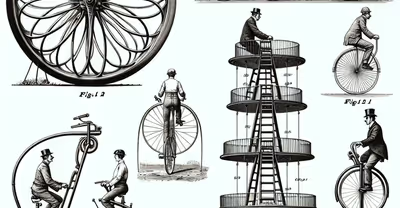
Key Takeaways
- Bikes have an intriguing science behind their stability, preventing riders from falling over.
- Balance is maintained through a combination of design features and rider adjustments.
- Innovative technologies enhance bike stability.
Ever wondered why you don't just topple over when you're cycling? Here are the reasons why bicycles stay upright.
Your bike stays upright because of gyroscopic stability, center of mass and balance, steering and counter-steering, and trail and caster effect. The rider's skill and experience, rolling friction, and forward momentum also work together to maintain equilibrium and prevent mishaps during your ride.
With a profound understanding of the physical principles governing bike stability, I possess a deep knowledge of the intricacies involved. My familiarity with gyroscopic effects allows me to provide a comprehensive and accurate explanation of why bikes remain upright. As such, I’ll deliver easily understandable information that demystifies the physics behind this phenomenon, ensuring that you gain a clear and informed understanding of the topic.
Why Do Bikes Stay Upright?
Ever zoomed down a hill on your bike and wondered how it magically stays upright without you toppling over?
Bicycles stay upright due to several factors working together like a well-rehearsed orchestra. From gyroscopic effects and gravity to the way you unconsciously steer, there's much beneath the surface of this seemingly simple question.
Let's dive into the nitty-gritty details of these factors!
Gyroscopic Stability
Gyroscopic stability plays a pivotal role in keeping your bike upright and on course. When your bicycle wheels spin, they generate a gyroscopic effect akin to a spinning top.
This phenomenon resists any external forces attempting to knock the bike off balance. It's important to note that the strength of this gyroscopic force is directly proportional to the speed at which your wheels rotate.
The faster they spin, the more robust the gyroscopic force becomes. This force is instrumental in maintaining your bike's upright position and resisting angular changes.
Consequently, it contributes significantly to the overall stability of your ride, especially when navigating corners or uneven terrain.
Center of Mass and Balance
The stability of your bike is intricately tied to the distribution of weight and balance. A low center of mass is a key factor in achieving overall balance.
When the center of mass is positioned closer to the ground, the bike-and-rider system becomes inherently more stable. This design element allows for better control and minimizes the risk of tipping over.
Additionally, the bike-and-rider system functions as a dynamic entity, constantly working to correct any tilting or leaning that may occur during your ride.
This self-correcting mechanism helps prevent falls and maintains the bike's equilibrium, allowing you to navigate various terrains and conditions with confidence.
Steering and Counter-Steering
The concept of steering and counter-steering may seem counterintuitive, but it's a fundamental aspect of bicycle stability. To initiate a turn effectively, you must first steer ever so slightly in the opposite direction of your intended path.
This counter-steering action induces a lean in the bike, allowing it to carve the desired trajectory. When you want to turn left, you briefly steer right, and vice versa.
It's this nuanced interplay between steering and counter-steering that allows you to navigate curves smoothly and maintain stability while changing direction.
This phenomenon is a testament to the dynamic and intricate nature of bicycle physics, where precise control leads to graceful and controlled maneuvers.
Trail and Caster Effect
The concept of trail is a vital contributor to bicycle stability, often going unnoticed but playing a crucial role. Trail refers to the distance between the point where the front wheel touches the ground and the steering axis.
It's essentially the offset between these two points. This seemingly minor detail creates a self-correcting mechanism for your bike, similar to the front wheels of a shopping cart.
When you steer your bike, the trail effect comes into play. As you lean the bike into a turn, the front wheel naturally aligns itself with the direction of the turn. This alignment helps maintain stability and ensures that your bike follows the intended path.
The trail effect is a hidden hero of bike stability, quietly working behind the scenes to keep you upright and on course.
Rider's Skill and Experience
While the physics of bicycle stability are essential, the rider's skill and experience are equally significant factors in maintaining equilibrium. Expert riders possess an intuitive understanding of their bikes and the ability to make quick, subtle movements to maintain stability.
These riders can adjust their balance and control their bikes effortlessly, even in challenging situations.
New riders, on the other hand, embark on a learning journey where balance and control are gradually developed through practice. This subconscious wizardry involves honing their proprioception, which is the body's sense of its position and movement.
As riders gain experience, they become more attuned to their bikes, allowing them to navigate a wide range of conditions and terrains while maintaining stability.
Rolling Friction
Friction, often viewed as an impediment, actually plays a crucial role in maintaining bike stability. The friction between the tires and the road provides the necessary grip to prevent slipping and sliding.
It's this friction that allows your bike's tires to roll smoothly, contributing significantly to overall stability. When you corner or brake, the friction between the tires and the road is what enables your bike to maintain traction and control.
The right balance of tire pressure, tire type, and road conditions all influence the level of rolling friction, affecting your bike's stability and handling.
Understanding and optimizing rolling friction are essential aspects of bike maintenance and riding skills, ensuring you can ride confidently and safely in various environments.
Forward Momentum
Finally, forward momentum is a critical factor in bicycle stability. A moving bike is inherently more stable than a stationary one.
When you pedal and maintain forward momentum, your bike's wheels exhibit gyroscopic stability, generating the necessary forces to keep the bike upright.
This forward motion creates a dynamic equilibrium that helps counteract external forces, such as gusts of wind or uneven terrain. Consequently, the bike feels more stable and responsive when in motion.
To enhance stability, it's essential to maintain a steady, continuous roll by pushing on the pedals, ensuring that your bike remains balanced and less susceptible to disturbances.
Innovations in Bicycle Design and Stability Enhancements
Have you ever wondered how modern bicycles seem almost magically to keep you upright with such ease? It's a dance of science and tech, and innovators are endlessly crafting new moves.
Bicycles have come a long way from the "boneshakers" of the 19th century, and it’s all thanks to the brains of engineers who've pushed the envelope of stability.
The following table shows how innovative technologies enhance bike stability:
Frequently Asked Questions
Here are the FAQs on why bikes stay upright.
What part do the design and geometry of a bicycle play in its ability to stay upright?
The rake of the fork, the frame's angles, and the wheel size—all these geometrical aspects influence stability.
Why is it that a bicycle in motion remains balanced, but tips over when stationary?
In motion, a bicycle's wheels act like gyroscopes and create a stabilizing force. Plus, when you're moving, you have the magical ability to steer into balance. When still, you lose both those handy abilities, meaning the slightest nudge could send you or your bike toppling.
In what ways does a spinning wheel contribute to the stability of a bicycle?
The spinning creates gyroscopic forces which, to get a bit technical, resist angular movement—meaning it's hard to tip them over. This force works alongside the 'trail'—giving you that stability while riding your bike.




















































































































































































































































































































































































































































































































































































































































































































































.avif)
